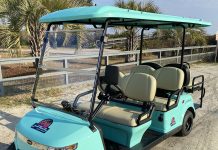PLEASE NOTE: Golf Cart Laws may vary from City to City, so please be sure to check with your local municipality in regards to the laws in your area. We are in the process of gathering laws by municipality for you, however, this is a huge undertaking and does take time. Thank you.
This is an in-depth guide to Minnesota Golf Cart & Low-Speed Vehicle Laws. We’ve created this guide to help you, the consumer, in determining Minnesota’s laws.
Is this state Medium Speed Vehicle friendly? Yes. Medium Speed Vehicles are allowed to go no more than 35 mph and operate on roads with a speed limit of 35 mph or less.
Is License and Registration a Requirement? For LSVs, yes. For Golf Carts, no, but if the local jurisdiction allows for golf cart use on their roads (see below) then a special permit and insurance is required.
General Federal Law for Golf Carts:
Under current NHTSA interpretations and regulations, so long as golf cars and other similar vehicles are incapable of exceeding 20 miles per hour, they are subject to only state and local requirements regarding safety equipment. However, if these vehicles are originally manufactured so that they can go faster than 20 miles per hour, they are treated as motor vehicles under Federal law.
The standard requires low-speed vehicles to be equipped with headlamps, stop lamps, turn signal lamps, taillamps, reflex reflectors, parking brakes, rearview mirrors, windshields, seat belts, and vehicle identification numbers.
Find out more information on federal laws pertaining to golf carts and low speed vehicles here.
Minnesota Golf Cart & Low Speed Vehicle Laws
Guidelines for Golf Carts and PTVs (Personal Transportation Vehicles)
The state of Minnesota allows for your local government to permit or not permit golf cart use on public roadways and highways under their jurisdiction. If they do allow golf cart use on public roadways and highways, then a special permit and insurance are required. Reach out to your local government for instruction on obtaining the permit.
Driver’s License is not required for golf cart operation under the special permit.
Drivers of golf carts are subject to the same traffic laws and duties as operators of other motor vehicles, although additional limitations apply. The vehicles can only be operated on designated roadways, although they may cross other roads and highways. The vehicles can only be operated between sunrise and sunset unless original equipment includes headlights, taillights, and brake lights. They cannot be used (1) in bad weather unless the authorizing ordinance provides an exception for emergencies, or (2) if there is not enough visibility to see people and other vehicles from 500 feet away.
Guidelines for LSV (Low Speed Vehicle)
- Has four wheels.
- Within one mile can reach a speed of more than 20 miles per hour (mph) but not more than 25 mph on a paved level surface.
- Has a 17-digit conforming vehicle identification number (VIN) and a manufacturer’s certificate of origin clearly labeling the vehicle as a low-speed vehicle.
- Has a gross vehicle weight rating (GVWR) of less than 3,000 pounds.
- Must be certified to meet Federal Motor Vehicle Safety Standards (FMVSS) to be registered and operated on public streets, roads, or highways.
- Not be operated on any roadway with a speed limit above 35 mph.
LSVs may look like a golf-cart to the casual observer, but is actually a motor vehicle requiring a valid driver license, registration, and insurance.
SPECIAL NOTE: Local Jurisdiction may prohibit the use of LSVs on public roadways.
HELPFUL LINKS
www.house.leg.state.mn.us – Golf Carts
www.senate.mn – Low Speed Vehicles
Disclaimer
Although each of these state guides gives a thorough approach to the golf cart laws in your state, it is recommended that you perform the research on your own and reach out to your local municipality.
Recent News & Helpful Articles












